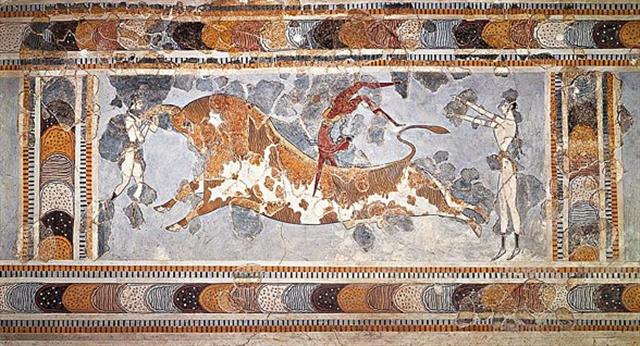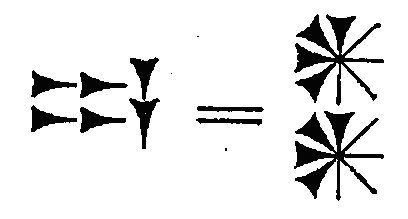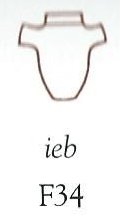160. The
creator of the C text could have defined what he
meant with his glyph type niu also by
using number 407 for this
purpose, cfr glyph number 407 in the G
text:
 |
 |
 |
 |
|
Gb6-25 (366 + 41) |
Gb6-26 (408) |
Gb6-27 (229 + 180) |
Gb6-28 (181) |
|
0h (365.25)
no star listed (365) |
Al
Fargh al Thāni-25 (Rear Spout)
CAPH = β Cassiopeiae,
SIRRAH
(Navel of the Horse) = α
Andromedae
(0.5), ε Phoenicis, γ³ Oct.
(0.8) |
Uttara Bhādrapadā-27
/
Wall-14
(Porcupine)
ο Oct. (1.3),
ALGENIB PEGASI
= γ Pegasi
(1.8) |
χ Pegasi (2.1), θ Andromedae
(2.7) |
|
March 20 (*365) |
21 (0h) |
22 (*1) |
23 (82 = 41 + 41) |
|
"Febr 7 |
8 (*325 = *366 - 41) |
9 |
10 (41 = 181 - 140) |
At the time of Bharani this
had been the
1st day after 0h (and 39 days after
"February 10):
 |
5 |
 |
 |
 |
 |
|
Cb1-6 (398) |
Cb1-12 (354 + 50) |
Cb1-13 |
Cb1-14 (350 + 8 * 7) |
Cb1-15 (407) |
|
te pahu |
manu rere - kua rere ga manu
- ki te ragi |
eaha te nuku erua |
koia kua huki |
e niu tu |
|
Al Ghafr-13 (Covering) /
Svāti-15
(Very Good)
TAHUA-TAATA-METUA-TE-TUPU-MAVAE
ARCTURUS, SYRMA (*215) |
31 Bootis (222.0),
YANG MUN (South Gate) = α Lupi
(222.1),
RIJL AL AWWA (Foot of the
Barker) = μ Virginis
(222.5), ο Bootis (222.9) |
IZAR (Girdle) = ε Bootis
(223.0),
109 Virginis, α Apodis (No Feet)
(223.3), μ Librae (223.8) |
Al Zubānā-14a
/
Visakha-16 (Forked) /
Root-3 (Badger)
ZUBEN ELGENUBI (*224) |
KOCHAB
(Kakkab, the Star) = β
Ursae Min.
(225.0), ξ Librae (225.7) |
|
Oct 22 (295) |
Oct 28 (300 + 1) |
29 |
30 |
31 |
|
MIRA (*33 = *215 - 182) |
μ
Arietis (39.4),
HEAD OF THE FLY = 35 Arietis
(39.6),
KAFFALJIDHMA = γ Ceti,
θ Persei (39.8) |
π
Ceti, ο Arietis (40.0),
ANGETENAR (Bend in the River) =
τ¹ Eridani,
μ Ceti (40.2),
RIGHT WING = 39 Arietis
(40.9) |
BHARANI (*41 = *224 - 183) |
TA LING (Great Mound)
= τ
Persei (42.4) |
|
April 23 |
April 29
(118 + 1) |
30 |
May 1 (121) |
2 |
|
'March 27 (*6) |
'April 2 (92 = 91 + 1) |
3 |
4
(*14 = *41 - 27) |
5 |
|
"March 13 (*358) |
"March 19 (*364) |
3-20 (*365) |
0h (*366) |
"March 22 (*1) |
|
FEBR 18 (*335) |
BIS-SEXTUM |
FEBR 25 |
26 (*343 = *366 - 23) |
27 (58 = 122 - 64) |
|
29 |
35 |
36 |
37 = 41 - 4 |
38 = 58 - 20 |
|
394 = 398 - 4 |
400 = 35 + 365 |
401 |
402 = 406 - 4 |
403 |
|
The sequence of heliacal star
dates in the text seems here to
make a jump ahead with 1 place,
because *366 = 365 + 1 and from
Arcturus, Syrma (*215) to Zuben
Elgenubi (*224) there were not 9
but 8 days. |
|
... The leap day
was introduced as part of the
Julian reform. The day following
the Terminalia (February 23) was
doubled, forming the 'bis
sextum - literally 'double
sixth', since February 24 was
'the sixth day before the
Kalends of March' using Roman
inclusive counting (March 1 was
the 'first day'). Although
exceptions exist, the first day
of the bis sextum
(February 24) was usually
regarded as the intercalated or
'bissextile' day since the third
century. February 29 came to be
regarded as the leap day when
the Roman system of numbering
days was replaced by sequential
numbering in the late Middle
Ages ... |
 |
Thus it should be the birth
place of the Morning Star (*) - the Egg or
the Nut where a new generation
'crept forth from their hiding places':
 |
 |
|
Rogo |
niu |
... γ,
4.1, greenish, on the right arm at the inner
edge of the Urn, and the westernmost [?]
star in the Y, is Sadachbia, from
Al Sa'd al Ahbiyah, which has been
interpreted the Lucky Star of Hidden Things
or Hiding-places, because when it emerged
from the sun's rays all hidden worms and
reptiles, buried during the preceding cold,
creep out of their holes!
Notably
β Ursae Minoris
(Kochab) followed in the day after Zuben
Elgenubi:
... at the
ancient time of Bharani the star at the
North Pole was not Polaris but
β Ursae Minoris - Kochab (as in
Babylonian Kakkab = Star).


Evidently there was a
tradition with a star high up for drawing
down a
line to the point at the equinox, from Alcor
to Spica for instance.

The Chinese Heart
station was referring to Alcor (the Fox) and this
'heart' had been close to the Full Moon when
Hyadum II was at 0h:
... In the inscriptions of Dendera,
published by Dümichen, the goddess Hathor
is called 'lady of every joy'. For once,
Dümichen adds: Literally ... 'the lady of
every heart circuit'. This is not to say
that the Egyptians had discovered the
circulation of the blood. But the
determinative sign for 'heart' often figures
as the plumb bob at the end of a plumb line
coming from a well-known astronomical or
surveying device, the merkhet.
Evidently, 'heart' is something very
specific, as it were the 'center of gravity'
... See Aeg.Wb. 2, pp. 55f. for sign of the
heart (ib) as expressing generally
'the middle, the center'
...

|
1 |
Horn |
α Virginis (Spica) |
Crocodile |
(202.7) |
Oct 9 (282) |
|
2 |
Neck |
κ Virginis |
Dragon |
(214.8) |
Oct 21 (294) |
|
3 |
Root |
α Librae (Zuben Elgenubi) |
Badger |
(224.2) |
Oct 31 (304) |
|
4 |
Room |
π Scorpii (Vrischika) |
Hare |
(241.3) |
Nov 17 (321) |
|
5 |
Heart |
σ Scorpii |
Fox |
(247.0) |
Nov 23 (327) |
|
0h |
MARCH 22 (*1) |
23 (82) |
|
no glyph |
 |
 |
|
Ga1-1 |
Ga1-2 |
|
HYADUM II = δ¹ Tauri
(64.2) |
Net-19 (Crow)
AIN (Eye)
= ε Tauri, θ¹ Tauri, θ² Tauri
(65.7) |
no star listed (66) |
|
May 24 |
25 (145) |
26 (*66) |
|
°May 20 |
21 (*61) |
22 (142) |
|
'April 27 |
28 (118) |
29 (*39) |
|
"April 13 |
14 (104) |
15 (*25) |
|
NAKSHATRA DATES: |
|
SEPTEMBER 20 (*183) |
21 (264) |
EQUINOX |
|
Heart-5
(Fox)
σ SCORPII
(247.0),
HEJIAN = γ Herculis
(247.2), ψ Ophiuchi (247.7) |
ρ
Ophiuchi (248.1),
KAJAM = ω Herculis
(248.3), χ Ophiuchi (248.5),
SHE LOW (Market Tower) = υ
Ophiuchi,
Tr. Austr. (248.7), ζ Tr. Austr.
(248.8) |
Al Kalb-16
(Heart) /
Jyeshtha-18 /
ANA-MUA-1 (Entrance pillar)
ANTARES
= α Scorpii
(249.1),
MARFIK = λ Ophiuchi,
φ Ophiuchi (249.5), ω Ophiuchi
(249.8) |
|
November 23 (327) |
24 |
25 (*249) |
|
°November 19 |
20 (*244) |
21 (325) |
|
'October 27 (300) |
28 |
29 (*222) |
|
"October 13 (286) |
14 |
15 (*208) |
And the Arabs had their 16th station at Antares, similarly named The Heart (Al Kalb).
The distance between a right ascension
line drawn from Alcor to Spica
(submerged like a Crocodile)

and the day where the Sun was rising like the Eye of the Bull
could be determined as
*202 (Spica) - *65 (Ain) = 137 days (significantly equal
to the day number for May 17 - in the day after
heliacal
Alcyone). Or, measuring by moving with the Sun,
the distance was 366 - 137
= 229 days (significantly equal to the number of glyphs on
side a of the G tablet).
|
314 |
 |
47 |
 |
 |
 |
|
Ca6-11 (151) |
Ca8-1 |
Ca8-2 |
Ca8-3 (202) |
|
te heheu ke -
te niu kua huri |
Etoru marama |
|
SADALMELIK (*334) |
ν Phoenicis (17.4), κ Tucanae
(17.6) |
no star listed (18) |
ADHIL = ξ Andromedae (*19) |
|
Febr 18 (49) |
April 7 |
8 |
9 (99 = 282 - 183) |
|
DEC 17 (168 + 183) |
33 = 351 + 48 - 366 |
FEBR 3 |
4 |
|
REGULUS (*152 = *334 - 182) |
σ
Virginis (200.4) |
γ
Hydrae (201.0), ι Centauri
(201.4) |
SPICA
= α Virginis,
ALCOR
= 80 Ursae Majoris
(*202 = *19 + 183) |
|
Aug 20 (232) |
Oct 7 |
8 |
9 (282 = 232 + 50) |
|
ºAug 16 (*148) |
ºOct 3 (*196) |
4 |
5 |
|
'July 24 (*125) |
'Sept 10 |
11 (254) |
12 (*175) |
|
"July 10 (*111) |
"Aug 27 |
28 (240) |
29 (*161) |
|
JUNE 17 (168 = 2 * 84) |
AUG 4 (*136) |
5 |
6 (218 = 282 - 64) |
|
148 = 152 - 4 |
196 |
197 |
198 = 218 - 20 |
|
314 + 51 = 365 |
|
... Proclus informs us that the
fox star nibbles continuously at
the thong of the yoke which
holds together heaven and earth;
German folklore adds that when
the fox succeeds, the world will
come to its end. This fox star
is no other than Alcor,
the small star g near zeta Ursae
Majoris (in India Arundati,
the common wife of the Seven
Rishis, alpha-eta Ursae ... The
Arabs in the desert regarded it
as a test of penetrating vision;
and they were accustomed to
oppose 'Suhel' to 'Suha'
(Canopus to Alcor) as occupying
respectively the highest and
lowest posts in the celestial
family. So that Vidit Alcor,
et non lunam plenum, came to
be a proverbial description of
one keenly alive to trifles, but
dull of apprehension for broad
facts ... |
I.e. when Spica and the Fox
had been at the Full Moon in FEBRUARY 4
(35), then there would have been 46 days to
the Crow in MARCH 22 (81).
Furthermore, 46 + 137 = 183 = 229 - 46.
... There was no water in the village. The
lakes and rivers were dry. Raven and Crow,
two young girls who were having their first
menstrual courses, were told to go and draw
water from the ocean. Finding the journey
too long, Raven decided just to urinate into
her basket-bucket. She decieved no one and
was severly scolded. Crow returned much
later but with drinking water. As a
punishment, Raven was condemned never to
find water in the summer; only in winter
would she find something to drink. For that
reason the Raven never drinks during the hot
months; she speaks with a raucous voice
because of her dry throat
...

|
















